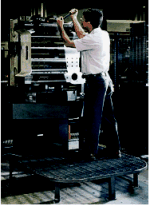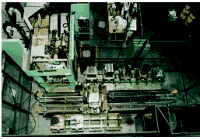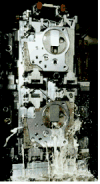Keep Your Spindles Cutting
Machining centers are marvelously flexible tools for getting production efficiency. Moreover, arranging machining centers into affordable, flexible cells allows shops to push the efficiency envelope even further.
Share





If you use CNC machining centers in your manufacturing operation, you've already taken a big step toward improving throughput in your shop. It also means your shop already possesses most of the basic skill sets that are necessary to move into automated cellular manufacturing.
Compared to its predecessors, even a basic CNC machining center is capable of performing many more tasks in a single setup. Today's flexible manufacturing cells are designed as an extension of the horizontal CNC machining center with operational software that complements a CNC operator's skills.
Shops have become adroit at using machining centers. Some of this successful application has come from a conscious effort by builders to make machine tools more productive.
A CNC machining center today is significantly more capable than an equivalent machining center was ten years ago—at a fraction of the price. Moreover, simplified operation and reliability is a reality in large part because of advances in control technology.
Likewise, a $500,000 flexible cell offers higher spindle utilization than its predecessor, the flexible manufacturing system (FMS), which cost several million dollars. The quest for today's metalcutting shop is to keep a machine tool making chips at the highest percentage of available time.
Let's say that a well applied stand-alone machining center is operated at close to maximum efficiency. What kind of productivity can a shop expect to achieve and how can they improve on it? That was one of the questions we put to Mark Adkins, Machine Tool Group Director of Market Development for Cincinnati Machine (Cincinnati, Ohio).
Mr. Adkins' group is working to take the machining center to its next evolutionary step—automated cellular manufacturing. They believe that for the same reasons a machining center is a staple of manufacturing today, cells made up of one or more machining centers will be, for many shops, a de facto metalcutting standard unit in the near future.
The driver is the same, as always: compressing partmaking by keeping the spindle in the cut as much as possible. For Milacron, the best method to achieve this is to use standardized cells—built around horizontal machining centers—that are as affordable and simple to operate as a stand-alone machine.
40, 60, 90 Percent
Most shops operate with a progressive style of manufacturing. Work moves from station to station with various operations performed at each stop.
Spindle utilization is an important measure of a shop's processing efficiency. When setup and workhandling are factored into the processing time for a given part, a good utilization rate for a stand-alone machine (with a two-pallet shuttle) is 40 percent.
"Walk into most shops in this country and count the number of spindles in the cut," says Mr. Adkins. "In most cases there are significantly fewer spindles cutting than spindles available to cut. What you see in these shops is usually not a lack of work, rather, it's the 60 percent of time that a stand-alone machining center spends getting ready to cut."
Cincinnati Machine figures that if a shop uses a machining center with a multipallet shuttle, usually six or eight stations, that in-cut time can go to 60 percent because workpiece loading and unloading can be done while the spindle is cutting; thus more jobs are immediately ready to be processed. Next, consider a machining center with a rail-guided vehicle and sequencing logic in its CNC. Now, in-cut time moves into the 90 percent range.
"That's the direction we see shops moving," says Mr. Adkins. "Shop size is no longer a determining factor for efficiency. Manufacturing in total is being driven to reduce costs and increase flexibility. Increasing the time a spindle spends in the cut is key to achieving that efficiency."
What Takes So Long?
Because metalworking manufacturing is so very application-specific, every shop has unique wrinkles in how it processes work. However, according to Cincinnati Machine, manufacturing costs can be distilled into two main elements. As a part is processed in the shop, at any given point on the journey it is either having value added or it is waiting to have value added.
In some cases the percentage of non-value added time can be 95 percent of the total time a part is in process. That of course means value is being added to the workpiece during a paltry five percent of the total.
Component elements of these non-value added times are material handling from raw stock to station and from station to station, setup time, and inspection. In-cut wait time includes tool changes, spindle acceleration/deceleration, and traverse to and from the workpiece.
The name of the game is to decrease the amount of time that a workpiece spends waiting for value to be added. Increasing spindle utilization, by repeatedly and rapidly providing the right part to the machining center spindle, is a key strategy for shops looking to reduce costs and move more work through the shop.
Who Needs A Cell?
The heart of a flexible manufacturing cell is the machining center. Horizontal spindle machining centers are the dominant design for inclusion in automated manufacturing cells.
"Horizontals offer easier access to the spindle for material delivery," says Mr. Adkins. "The design also has a virtually unlimited tool storage capacity, which is critical for rationalizing a cellular manufacturing strategy. Palletized workpieces allow progressive machining of multiple parts on tombstone fixtures or multi-sided machining of prismatic parts in one setup."
While the conventional idea of a cell involves multiple machining centers, Cincinnati Machine begs to differ with this concept. "We consider a cell to be the equipment necessary to maximize part production," says Mr. Adkins. "That may require only one machining center serviced by a pallet storage and delivery unit and run using the machining center's CNC with cell control software. This minimum equipment cell can deliver 90 percent spindle utilization."
There are several indicators for a shop that might signal a look at flexible cell manufacturing. A shop's inability to keep up with incoming orders is an important flag that indicates throughput is insufficient. In a busy shop, it takes a large number of stand-alone machines operating at 40 percent spindle utilization to match an automatic cell cranking at 90 percent.
"We usually see about a four-to-one spindle ratio when cells are installed," says Mr. Adkins. In those cases an optimized, one-machine cell can replace four manual or two stand-alone CNC machines.
A need for more flexibility is another reason to consider cells. For example, if numerous engineering changes are made by the shop's customers, these changes can wreak havoc on process control.
"In a sequential manufacturing setup," says Mr. Adkins, "changing a part spec can affect several machine tools. If there is process equilibrium—each operation takes about the same time—this can be upset if an individual cycle time is lengthened or shortened. A change in product mix can also have a domino effect down the production line."
To compensate for some of these vagaries, many shops produce job overruns to help speed delivery response on repeating orders. Frequent engineering changes can make this very risky because it takes only one change to render an entire inventory scrap.
Pick A Cell
Modularity, from the use of standard components, is probably the biggest advance in cell technology. Mechanically, flexible cells come ready to go "off-the-shelf," because most machine tool builders offer a version of the cell. Electronically, cell controllers use software that is modular as well, allowing it to be customized to fit application needs.
Some early attempts at random flexible manufacturing—the FMS—were not financially successful. "In the early days each system was unique," says Mr. Adkins. "We invented the wheel every time a project came along. The computers alone, with the power necessary to run a multi-machine system, cost $500,000 in those days. That put a price on the complete system into the millions and multi-millions of dollars. Shops couldn't get a satisfactory return on such a huge investment. Now an entire cell, machine, random pallet delivery system, control, and software costs what an FMS computer did alone."
Job shops and contract manufacturers live off of contracts. Shop capacity is based on how many parts need to be made. Expanding capacity usually means adding machines.
Modular design allows a shop to incrementally expand a cell as business conditions dictate. And, according to Milacron's calculations, every spindle added to a cell is producing at a rate double that of a stand-alone CNC machining center.
Machining Against Time
Competition is driving shops to become ever more efficient at metalworking manufacturing. While competition includes other shops, there are internal drivers within each shop.
Time is among the biggest internal competitors for a shop. Machines waiting for work cost money and business opportunities. The idea of cellular manufacturing is to perform all operations on a workpiece in one handling. A raw part goes in and a complete part comes out. Instead of having batches of work sitting around waiting to be moved to secondary or tertiary operations, they get machined and shipped.
A cell imposes discipline on the shop floor. An operator could make the processing decisions that a cell controller can make but it is a rare person who can keep up with all of the possibilities.
Shops have a fixed amount of hours that a given machine tool can cut metal, be it per day, week, month, or year. To get more production a shop can add machines, which means more operators, which are increasingly hard to find, or add shifts, which still poses the problem of finding people, or get more utilization from each spindle. That includes the ability to go untended or lightly tended for significant periods of time.
Control Is Key
In an automated cell, the controller effectively takes the place of the shop foreman function. A cell controller's job is to make decisions based on the dynamic conditions that are occurring in the process.
Information is resident in memory and used to appraise situations, such as tool life monitoring, in order to keep the cell's spindles as close to fully engaged as possible.
Like a foreman who knows how to "slip" in a job, the cell controller is designed with the intelligence to find an appropriate job in queue based on numerous criteria. Unlike the foreman, the cell controller operates without interruption—24 hours a day.
Volume Versus Variety
Metalworking shops are pretty much defined by where they fit on the volume versus variety continuum. Low volume, high mix shops and manufacturers of prototypes are at one end, while high volume, low mix manufacturers are at the other end.
The obvious shop profile for cellular manufacturing would seem to be the former example of a high mix, low volume or prototype manufacturer. Shops like this can take very good advantage of cells because of the reduced setup requirements provided by multiple pallets and the job scheduling capability of the controller.
Moreover, shops with production that has less mix and higher volume can also be good candidates for cells because a cell can be programmed and changed as opposed to using hard automation, which is purpose-built. "For high volume producers, the cell controller's flexibility becomes less important in day-to-day operations," says Mr. Adkins. "However, when a job is run and a change is needed, the speed and ease of changeover for an automated cell is significantly less than other production systems."
A World Of Cells?
It's probably a stretch to envision the flexible cell becoming as common in metalworking shops as is the machining center. It is not, however, too much to see a time when most shops use a cell or at least the concept of cellular manufacturing in some operations for selected jobs with tight margins or deliveries.
There are many ways to get costs down, and cellular manufacturing is a very attractive one. Builders like Cincinnati Machine have done a good job designing cells into off-the-shelf modules that allow shops to start small and grow the cell with the business.
With spindle utilization rates of 90 percent, shops will have to take a closer look at either purchasing that kind of productivity or emulating it. One thing is for sure, competition for a shop's productive hours is not going to lessen.
Related Content
Inside a CNC-Machined Gothic Monastery in Wyoming
An inside look into the Carmelite Monks of Wyoming, who are combining centuries-old Gothic architectural principles with modern CNC machining to build a monastery in the mountains of Wyoming.
Read MoreInside the Premium Machine Shop Making Fasteners
AMPG can’t help but take risks — its management doesn’t know how to run machines. But these risks have enabled it to become a runaway success in its market.
Read MoreHow to Determine the Currently Active Work Offset Number
Determining the currently active work offset number is practical when the program zero point is changing between workpieces in a production run.
Read MoreBallbar Testing Benefits Low-Volume Manufacturing
Thanks to ballbar testing with a Renishaw QC20-W, the Autodesk Technology Centers now have more confidence in their machine tools.
Read MoreRead Next
Building Out a Foundation for Student Machinists
Autodesk and Haas have teamed up to produce an introductory course for students that covers the basics of CAD, CAM and CNC while providing them with a portfolio part.
Read MoreRegistration Now Open for the Precision Machining Technology Show (PMTS) 2025
The precision machining industry’s premier event returns to Cleveland, OH, April 1-3.
Read More5 Rules of Thumb for Buying CNC Machine Tools
Use these tips to carefully plan your machine tool purchases and to avoid regretting your decision later.
Read More




































